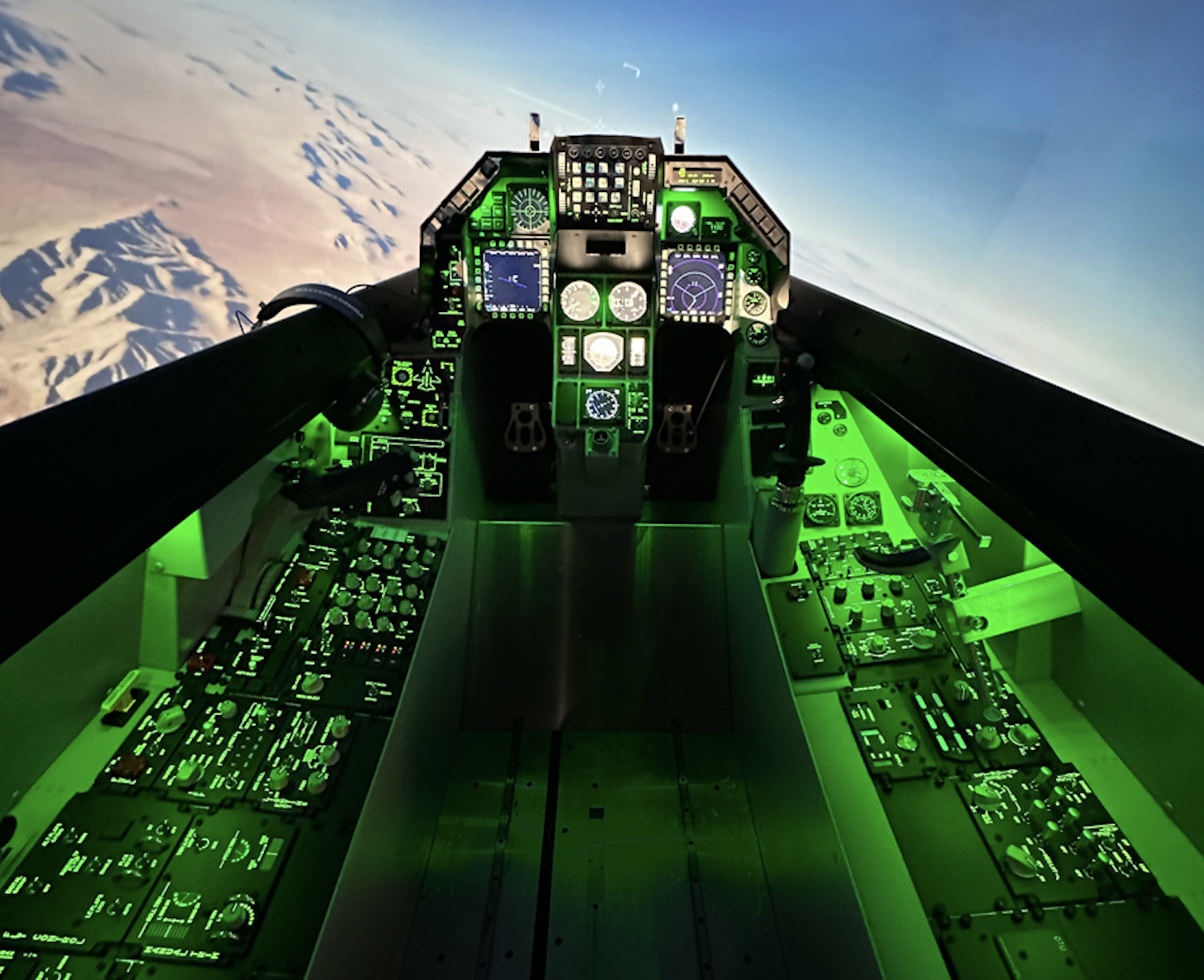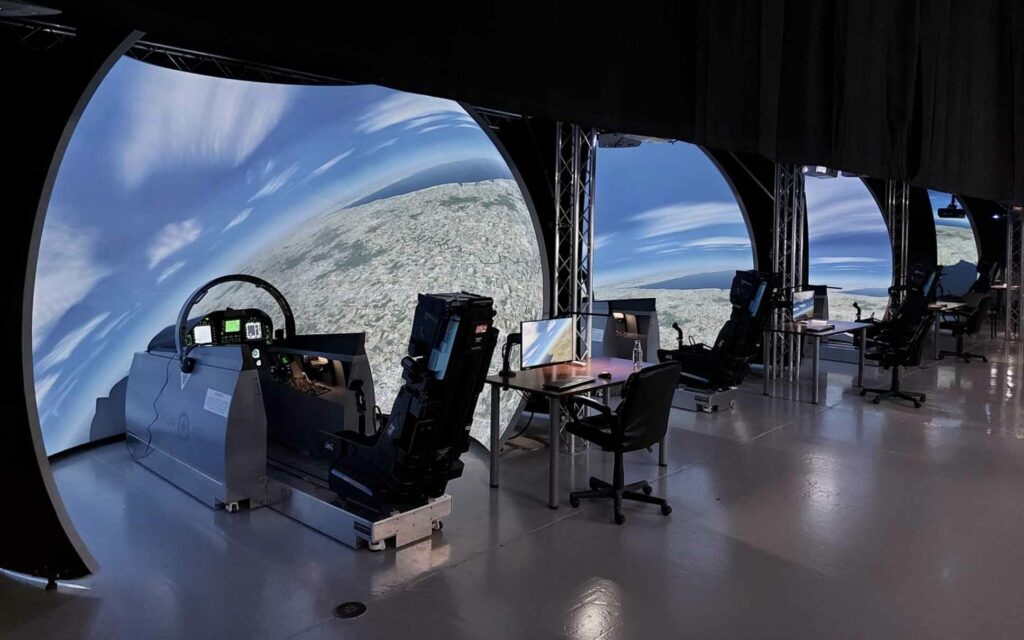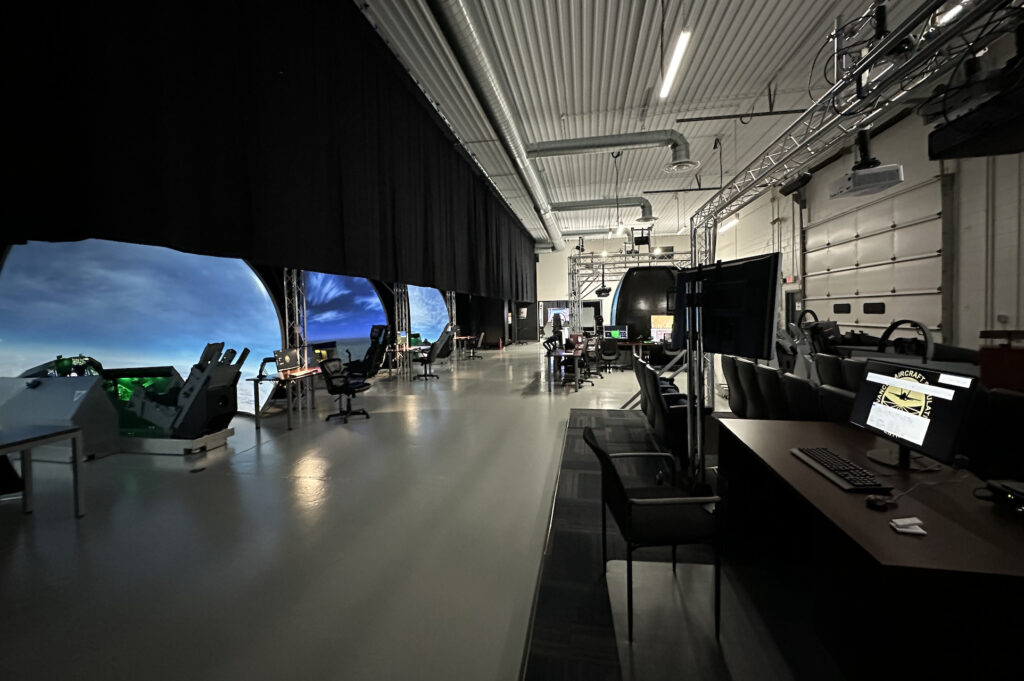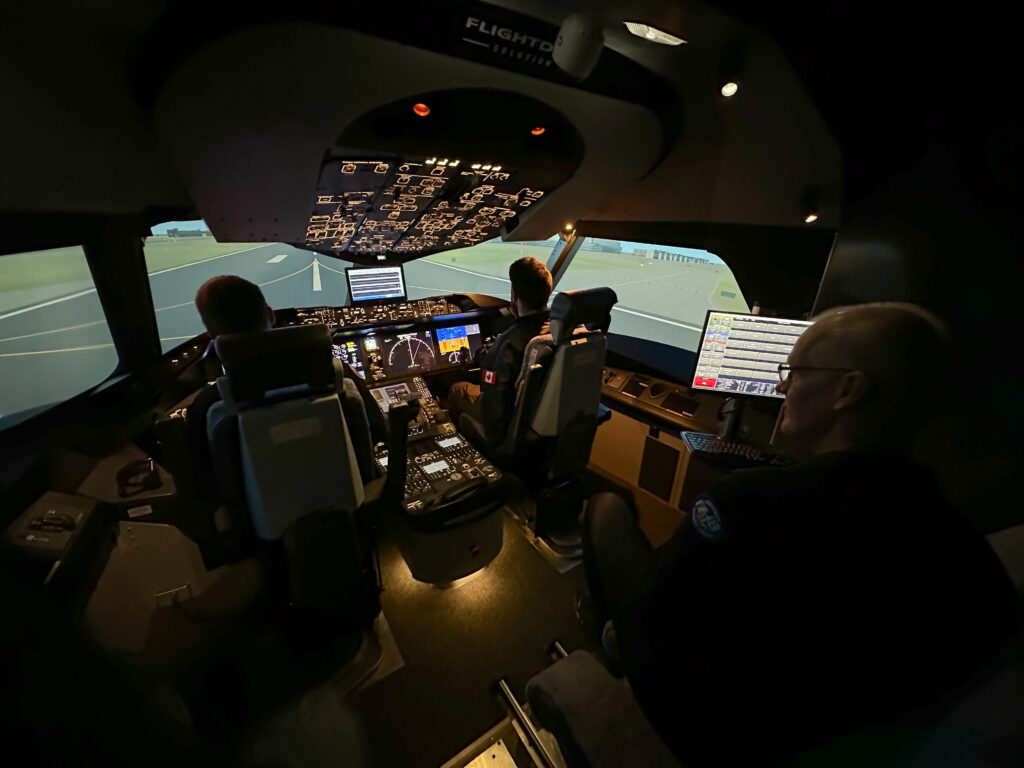Estimated reading time 14 minutes, 51 seconds.
Located at London International Airport (CYXU) in Southwestern Ontario, less than two hours south of Toronto Pearson airport, is a world-class test pilot training facility known as the International Test Pilots School Canada (ITPS).
While CYXU might not be easily spotted on a map, it has been home to ITPS for nearly two decades — allowing the company to grow into 10,000 square feet of office and classroom space and a 27,000-square-foot hangar. With a fleet of 22 fixed- and rotary-wing aircraft and an exceptional training curriculum — delivered by a team of 23 instructors from a variety of different countries — ITPS is one of only eight test pilot schools recognized on a global scale by the Society of Experimental Test Pilots.

A significant part of ITPS is its International Tactical Training Centre division, known as ITTC, which “is the only commercial entity providing advanced fighter pilot training — including fighter weapons instructor courses, advanced tactics courses, and mission commander courses — to international customers,” the company says.
In order to take its test pilot school and tactical training to the next level, the company invested in a new Advanced Aircraft Simulation Centre (AASC), right next to its hangar facility, which opened its doors in early 2021.
The technology and offerings in the AASC are second to none, with 12 fighter simulators, including four F/A-18Es, four F-35s, and four F-16Cs; two variable stability engineering simulators based on the F-16 and one based on the Boeing 787; one AW139 helicopter simulator; one attack helicopter systems simulator based on the Boeing AH-64D Block II aircraft; and an eVTOL simulator, which was developed by ITPS as an 18-bladed vehicle based on the Bell 206 helicopter frame.
Of course, some of the simulator platforms are strictly geared towards the tactical training center, while others are utilized by the test pilot school.
“I boldly say that I don’t think there’s anywhere else in the world you’d find a simulator center that is like this one,” said AASC manager Steve Bigg. “When you look at the use here for flight test and the use here for tactical training — and the assets that we have in-house — we’re globally unique.”

As realistic as possible
ITPS/ITTC has placed a lot of emphasis on technology to bolster its flight test and tactical training programs. One technological advancement that the school recently started using in its sim center is referred to as “mixed-reality.”
A step up from virtual reality (VR), mixed-reality blends together the physical and digital worlds for an even more immersive experience.
Bigg explained: “The headset has stereo video cameras on the front, and that’s where the content that you see inside the cockpit comes from. Then you have to set up a portal. . . . Anything that’s inside the portal uses live video, and anything outside the portal will just use the VR content. Essentially, the simulation runs in VR, and then the video is superimposed on top of it in a 3D space.”
The result is that students are able to see their live view of everything inside the cockpit while wearing the headset, including their own hands. They’re able to physically push buttons and interact with the instruments, which offers valuable tactile feedback. Then, when they look around them, they’re flying in a virtual world.
“You can look over your shoulder at the back of the airplane,” said Bigg. “It’s complete spherical awareness in that environment.”
One of the challenges for ITTC when it sought to employ mixed-reality technology was the fact that the school uses multiple different types of software for different simulations, and it would become very complex to try to set each system up to run in mixed-reality.
“The company that manufactures the headsets realized there are a lot of limitations to people using the [mixed-reality] headsets if the software doesn’t natively support it,” noted Bigg. “So, they came up with another application that allows you to run [mixed-reality] in parallel with the VR simulation software. That was a game changer.”
There’s no doubt that mixed-reality technologies will better prepare the next generation of pilots to fly and test more advanced aircraft platforms. But taking things a step further — in terms of making training as realistic as possible while reducing costs and environmental impacts — ITTC is also taking advantage of Live Virtual Constructive Training (LVCT).
LVCT is essentially a blended training environment between simulators and real aircraft, allowing for “very realistic tactical training in complex scenarios at a relatively low cost,” ITTC says.
Within the AASC, the school has worked with the developers of the simulator software it utilizes to gain access to the back end of that software, so it can be adjusted to work with other third-party software, if needed, or fine-tuned to meet a specific training purpose.
“That access to the back end is critical for our path forward because our R&D lab, by the end of this year, will have some elements of the live virtual constructive and simulation environment put together with our Hawker Hunter T.7 aircraft, the sim center, and computer-generated forces from the integrated instructor operator station — all mixed together in the same fight,” explained Bigg.

During a training exercise in the Hunter, for example, “you won’t know if there’s another aircraft in the sky, if somebody’s in a simulator, or whether I’m injecting Red Air from the computer. That will all be tied into one system.”
Training capabilities
The AASC features four simulation domes, which any of the 12 fighter cockpits can be configured in — as they are all set up for “roll-in roll-out.” When the domes are full, other cockpit simulators can be rolled into a mixed-reality set up.
“It all depends on the scenario we’re running,” explained Brendan “Darcee” Pierce, head of training. “From a tactical perspective, we run everything from fighter lead-in training — where there’s just one pilot, in one dome, with one instructor — to two-ship or four-ship scenarios, and then all the way up to mission commander, 50 vs. 50-type aircraft scenarios.”
The mission commander course, in particular, is new to ITTC. Pierce said the course started this February, and the focus for the mission commander forces in the sim center is the “organization and deconfliction of the whole package,” he noted.
“We also can inject AI [artificial intelligence] Red Air, or Blue Air, in various levels,” added Pierce. “So we can have, let’s say, four Hornets, four F-16s, and four F-35s, where we’re flying the four Hornets and the four F-16s are flying a generated route with some form of AI. If we want control of those four F-16s, then whoever is at the operator station can take control those F-16s to maneuver them within the scenario how we want; we can do the same from a Red Air threat perspective with both surface-to-air and air-to-air threats — and some control over the jamming and electronic warfare spectrum.”
For large force exercises in the AASC where many control stations are required, the school has the ability to link its simulators with the telemetry room (located in ITPS’s main building), if space in the sim center is maxed out.
“We can control the scenarios from [our telemetry room] with the weapons controllers over the radios,” explained Pierce. “We also can put observers in here if students on the course want to watch when they aren’t in the sim center.”
While tactical training exercises are taking place in the AASC, instructors have the ability to watch the missions unfold in real time on a projection screen in the sim center’s mission lecture theater, which utilizes real-time Air Combat Maneuvering Instrumentation. The missions can then be played back for debrief purposes.
On the test pilot side, the school’s Boeing 787 simulator — which was built by Ontario-based Flightdeck Solutions — can be utilized to teach students a variety of different flight test techniques, including performance flying qualities, workload assessments, avionics assessments (thanks to the glass cockpit), and much more.
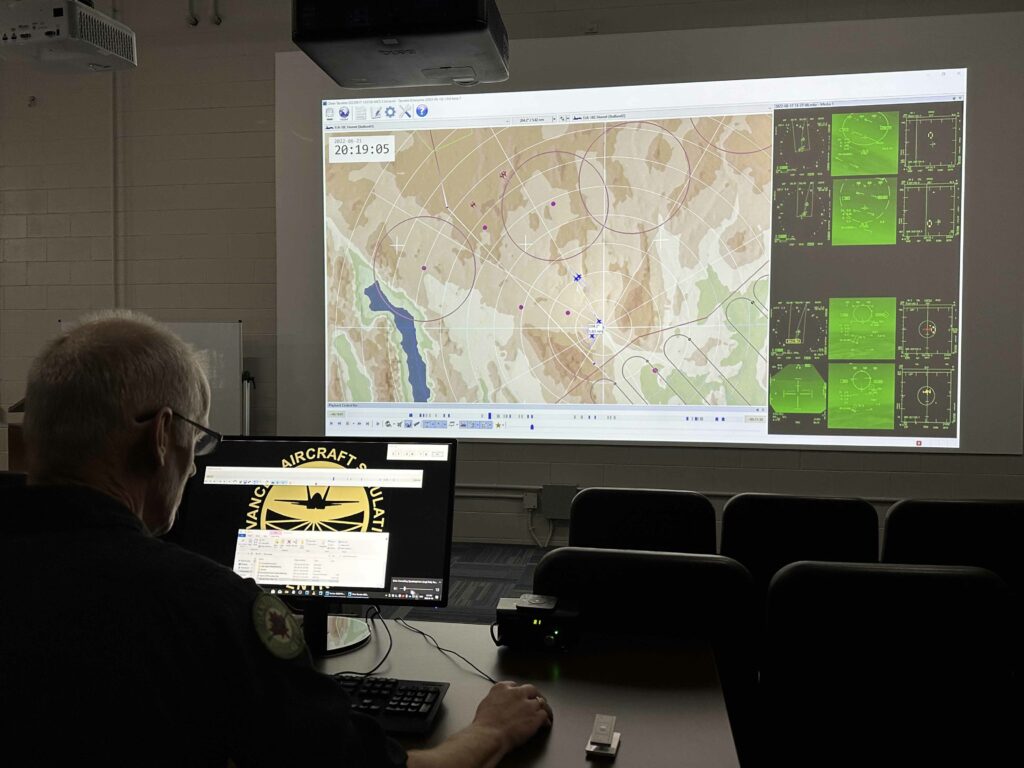
“We can put up any tailorable set of parameters, depending on what flight test technique we’re trying to teach our students,” explained David Lohse, deputy head of training at ITPS. “If we’re doing cruise performance, we might want to look at fuel flow, or angle of attack. If we’re doing flying qualities testing — like lateral directional static stability, for example — we might want to look at sideslip, rudder forces, aileron forces, or deflections. We can tailor all that, and we can tailor the scale, depending on what we’re teaching our students. . . . We can even connect to our telemetry room.
“Having an aircraft like the 787 is good for our clients in terms of offering a diversity of aircraft types,” added Lohse.
Preparing for the future, ITPS recently added an eVTOL simulator to the AASC, which the company developed in just five weeks. ITPS president Giorgio Clementi recognized that urban air mobility is likely to become a significant sector as far as flight testing goes, “because nobody even knows what the standards are going to be yet,” noted Bigg. Eventually, “there’s going to be a massive need for training in how to do eVTOL certification training.”
The eVTOL simulator is an 18-bladed aircraft based on a real Bell 206 airframe that the school had purchased. The original plan was to actually build the eVTOL using the Bell 206 frame, but that plan quickly shifted to a simulator, as it would be quicker to develop and would still allow the school to accomplish its goals. The real Bell 206 frame will eventually be transformed into a cockpit simulator for the eVTOL vehicle, and will be utilized in a mixed-reality set up.

Since opening its AASC roughly two years ago, the company said it has experienced “explosive growth in demand for training” from both existing and new customers. To date, ITTC has trained 26 air forces globally, including the Royal Canadian Air Force, Royal Australian Air Force, Royal Netherlands Air Force, Royal Malaysian Air Force, Royal Thai Air Force, Pakistan Air Force, and Indonesian Air Force, to name a few.
Company culture
A family-run business, ITPS/ITTC is continuing to grow its capabilities and offerings, with a diverse team of roughly 80 employees.
“We’ve got the experts, we’ve got the ideas and the capability, and we’re going to execute,” said David Clementi, chief operating officer at ITPS, who was instrumental in growing the company to where it is today. “We focus on hiring the people with the expertise and the knowledge, and then empowering them to get the job done.”
The ITPS and ITTC flight instructors, specifically, come from all corners of the world, which Clementi sees as a major strength.
“Each country has its own nuance and way of teaching people how to do things,” Clementi told Skies. “Here, they’re all being brought together to kind of discuss and identify the best ways of doing things, which allows us to create a superior organization and product. I think we’ve seen the fruits of that labor through some of the awards that have been garnered over the past couple of years.”
Ultimately, the bottom line for the company is that it is “here to change the way things are being done — [from a test pilot and tactical training perspective] — and it’s about time that that happens,” concluded Clementi. “It’s the innovation that we have here that gives our students exposure to unique and interesting ways of doing things.”
